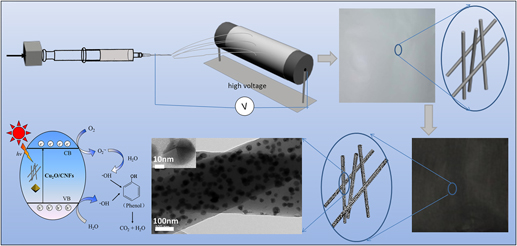Crossref Citations
This article has been cited by the following publications. This list is generated based on data provided by
Crossref.
Zhang, Peng
Dong, Zhiyuan
Ran, Yuanming
Xie, Hualin
Lu, Yun
and
Ding, Shimin
2018.
Preparation and photocatalytic application of AgBr modified Bi2WO6 nanosheets with high adsorption capacity.
Journal of Materials Research,
Vol. 33,
Issue. 23,
p.
3953.
Mahto, Madhusudan Kr.
Samanta, Dipanjan
Konar, Suraj
Kalita, Himani
and
Pathak, Amita
2018.
N, S doped carbon dots—Plasmonic Au nanocomposites for visible-light photocatalytic reduction of nitroaromatics.
Journal of Materials Research,
Vol. 33,
Issue. 23,
p.
3906.
Singh, Ravindra Pratap
2019.
Plant Nanobionics.
p.
115.
Su, Ruidian
Li, Qian
Chen, Yongsheng
Gao, Baoyu
Yue, Qinyan
and
Zhou, Weizhi
2019.
One-step synthesis of Cu2O@carbon nanocapsules composites using sodium alginate as template and characterization of their visible light photocatalytic properties.
Journal of Cleaner Production,
Vol. 209,
Issue. ,
p.
20.
Qiu, Taoyu
Zhu, Weiwei
Liu, Shaoyou
Chen, Kao
Liang, Siliang
and
Feng, Qingge
2019.
Solid state synthesis and characterization of n–p (SnO2)1.3/(α ∼ Bi2O3)x/(β ∼ Bi2O3)1−x photocatalyst modulated by PVA and its photocatalytic performance.
Journal of Materials Research,
Vol. 34,
Issue. 10,
p.
1805.
Capilli, Gabriele
Calza, Paola
Minero, Claudio
and
Cerruti, Marta
2019.
Electrospun core–sheath PAN@PPY nanofibers decorated with ZnO: photo-induced water decontamination enhanced by a semiconducting support.
Journal of Materials Chemistry A,
Vol. 7,
Issue. 46,
p.
26429.
Wu, Yanjie
Zhang, Huiping
and
Yan, Ying
2020.
Effect of copper ion-exchange on catalytic wet peroxide oxidation of phenol over ZSM-5 membrane.
Journal of Environmental Management,
Vol. 270,
Issue. ,
p.
110907.
Xu, Qin
Huang, Zhan
Ji, Shuting
Zhou, Juan
Shi, Rongzhen
and
Shi, Wenyan
2020.
Cu2O nanoparticles grafting onto PLA fibers via electron beam irradiation: bifunctional composite fibers with enhanced photocatalytic of organic pollutants in aqueous and soil systems.
Journal of Radioanalytical and Nuclear Chemistry,
Vol. 323,
Issue. 1,
p.
253.
Liu, Hao
Gough, Christopher R.
Deng, Qianqian
Gu, Zhenggui
Wang, Fang
and
Hu, Xiao
2020.
Recent Advances in Electrospun Sustainable Composites for Biomedical, Environmental, Energy, and Packaging Applications.
International Journal of Molecular Sciences,
Vol. 21,
Issue. 11,
p.
4019.
Puppin, Lara G.
Khalid, Mohd.
da Silva, Gelson T.T.
Ribeiro, Caue
Varela, Hamilton
and
Lopes, Osmando F.
2020.
Electrochemical reduction of CO2 to formic acid on Bi2O2CO3/carbon fiber electrodes.
Journal of Materials Research,
Vol. 35,
Issue. 3,
p.
272.
Chauhan, Ankush
Verma, Ritesh
Batoo, Khalid Mujasam
Kumari, Swati
Kalia, Rahul
Kumar, Rajesh
Hadi, Muhammad
Raslan, Emad H.
and
Imran, Ahamad
2021.
Structural and optical properties of copper oxide nanoparticles: A study of variation in structure and antibiotic activity.
Journal of Materials Research,
Vol. 36,
Issue. 7,
p.
1496.
Wang, Kunlei
Bielan, Zuzanna
Endo-Kimura, Maya
Janczarek, Marcin
Zhang, Dong
Kowalski, Damian
Zielińska-Jurek, Anna
Markowska-Szczupak, Agata
Ohtani, Bunsho
and
Kowalska, Ewa
2021.
On the mechanism of photocatalytic reactions on CuxO@TiO2 core–shell photocatalysts.
Journal of Materials Chemistry A,
Vol. 9,
Issue. 16,
p.
10135.
Geng, Jiguo
Ma, Jianling
Li, Feng
Ma, Shengqian
Zhang, Dong
and
Ning, Xuefeng
2021.
RETRACTED: Atomic layer deposition of Cu2O on NH2-MIL-101(Fe) for enhanced photocatalytic performance and decreased electron/hole recombination.
Ceramics International,
Vol. 47,
Issue. 10,
p.
13291.
Kim, Dong Su
Oh, Shin Young
Lee, Hak Hyeon
and
Cho, Hyung Koun
2024.
Harmonized Physical and Electrochemical Process Design for Densely Dispersed Cu Catalysts on Cu2O Absorbers for Efficient Photoelectrochemical CO2 Reduction Reaction.
Advanced Energy Materials,
Vol. 14,
Issue. 10,
Oh, Shin Young
Kim, Dong Su
Lee, Hak Hyeon
Lee, Kun Woong
Choi, Ji Hoon
Yang, Won Seok
Choi, Young Su
Kim, Dong Wook
Byeon, Jee Won
Lee, Ho Seong
and
Cho, Hyung Koun
2024.
Exactly regulated copper catalysts exploiting isolated photoelectrochemical reduction of cuprous oxides and random mesh-structured TiO2 for enhanced photoelectrochemical CO2 conversion.
Journal of Materials Chemistry A,
Vol. 12,
Issue. 26,
p.
15619.
Koe, Chee Meng
Pung, Swee-Yong
Sabar, Sumiyyah
Ul-Hamid, Anwar
and
Tan, Wai Kian
2025.
Growth of CuO rods on kanthal coil via direct heating for photocatalytic degradation of rhodamine B.
Environmental Surfaces and Interfaces,
Vol. 3,
Issue. ,
p.
77.
